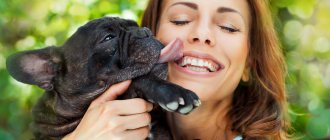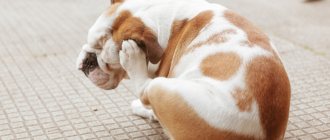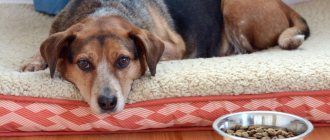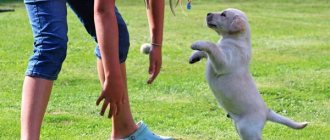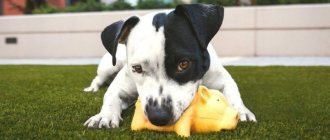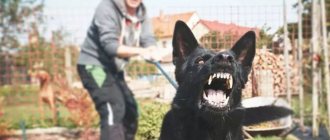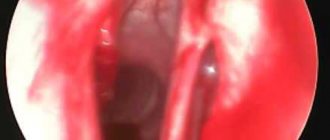A sudden change in a dog’s mood and behavior must have serious reasons. But the owner is not always able to resolve the conflict on his own and feels helpless. Let's take a closer look at the causes of the problem and find options to solve it.
What is the reason for this behavior?
A dog can not only growl, but also demonstrate his negative attitude in other ways - bare his teeth, bark, or not complete the task given to him. An angry animal may be overly protective of its bowl, toys, or other objects that the pet considers to be its own.
In addition, the dog can show excessive dissatisfaction during hygiene procedures that it especially does not like, for example, when trimming its nails, combing its fur, or using a trimmer.
But sometimes such behavior is not a sign of aggression, it signals that the pet is confused and feels defenseless. How can you find out the cause of the growling?
Experts identify several situations that can provoke growling, anxiety and other emotions in a dog:
- The dog considers himself the master of the house . Representatives of many breeds have a tendency to dominate, which they often display when communicating with family members and other pets. Often it is the spoiled individuals who become leaders, as the owner makes the mistake of trying in every possible way to please his four-legged friend. The animal begins to be jealous of its things - food, toys, not allowing the owner to approach and take them. In addition, the dog can also encroach on objects that do not belong to him. With a growl, he declares his rights and confirms that there is only one owner in the house!
- The dog responds to cruelty with aggression . In this case, the situation is the opposite - the pet is constantly faced with cruelty directed at it, and the growling becomes a warning signal - not to approach. A dog may also growl when it is being punished or scolded for misbehavior or for no reason.
- By growling, the dog shows a sense of ownership . This behavior is typical of teenage males, who not only grow and become stronger, but also try to assert themselves. During this period, many owners are faced with the fact that an obedient and flexible dog suddenly becomes uncontrollable. This happens due to natural instincts - the animal shows its leadership qualities, and the goal of such behavior is one - to become a leader. In addition to growling, the dog can violate previously established boundaries, occupying forbidden territory. Most often, it serves as the owner’s sleeping place. At the same time, we are not talking about any fear; with all his appearance, the male shows his fearlessness and confirms his importance.
- Food aggression . In this situation, the puppy may snatch the treat, biting his hand, or growl when the owner pets him while eating. An adult dog may grin or freeze while eating food if the owner comes too close or reaches out to the bowl. This behavior can be corrected; there are several methods for this.
- Aggression of a puppy bitch . A mother always tries to protect her offspring - this is a strong innate instinct that helps bitches ensure the safety of their babies. During this period, she can show anger towards other bitches, even for no apparent reason. And keep the owner away from the puppies at home, but most often this only applies to children.
- Reaction to pain . Dogs, especially those that are overly independent and active, are often injured, receiving external or internal injuries. Sometimes the owners don’t even know about it, or the dog has no visible wounds. Naturally, when touched, the pet may growl, move away, and whine.
In almost all of these situations, except for the dominant manifestation, there is an irritant that provokes the dog. But the most difficult thing to correct is the errors of upbringing, in which the dog allows itself to behave inappropriately towards the owner.
Why do dogs growl?
Dogs are social creatures. They gather in packs where a strict hierarchy reigns. Even the most domestic and sweet individuals adapt their instinctive nature to the conditions of the human environment. Growling is for animals what verbal aggression is for people. Every behavior has a reason, and growling is no exception.
A pet may exhibit unacceptable behavior for the following reasons:
- he considers himself a leader. Hierarchical aggression. Most often observed in animals at the stage of puberty, when individuals who have not decided on their status try to show their superiority and occupy a higher level;
- passionate about the game. It is especially common in games involving tug of war. The animal wants to win, forgets itself and begins to growl. If this behavior is not stopped, it can result in attempts to dominate;
- protects its food and territory from attacks. The owner, as the leader of the pack, must have access to all of the above. Encouraging the territorial instinct is only permissible if a guard dog is being raised;
- the pet experiences pain and discomfort. If we exclude painful conditions, then similar cases occur among families with small children. It is not uncommon for a dog to growl at a child who has not been taught proper handling of animals;
- there was a replenishment. A whelping female may snap at attempts to contact her and her offspring. In this way she tries to protect her cubs.
Some cowardly representatives of small breeds are distinguished by the manifestation of nervous and aggressive behavioral reactions. Such antics indicate attempts to protect themselves from the big and terrible world around them.
We recommend this article:
How to stop a dog from barking at home and at passers-by
Causes of aggression
There are 4 fundamental reasons why an animal can show aggression and growl at the owner.
- This list includes animal breeding that was poorly planned, in other words, not thought out at all.
- Also, a dog can grumble due to improper upbringing, aggression towards it, violence from a person, constant bullying (intentional provocation of evil).
- Another reason is the intrusiveness of children or guests (friends of the owner). A man's friend simply cannot calm down, because she is disturbed day and night. This is where aggressive signs and growling arise.
- It is necessary to highlight incorrectly carried out or late socialization, due to which the pet cannot adequately respond to other animals or people.
It is important to understand that aggression, as well as attachment, refers to the emotions of an animal. It is forbidden to proceed only from facts; you need to know your dog, feel its mood, listen to your own intuition. Wisdom, empiricism and kindness are your best allies. Of course, a dog’s emotionality should not be discounted.
Why does a dog develop dominant behavior and how does it manifest itself?
Dogs have been living next to humans for thousands of years, but at the same time, in essence, retain their pack behavior. Only they mistake the owner and household members for a flock. With proper upbringing, the dog perceives the owner as a leader; he must obey him. Both the pet and other family members must obey the leader.
If the puppy was not immediately shown who is boss in the house, then he perceives this as an opportunity to make his own choice. Naturally, he will appoint himself to this position, happily becoming the leader of the pack, and his behavior will be appropriate.
The leader's behavioral line develops gradually, starting with a little disobedience. The dog does not follow commands the first time, waiting and assessing the owner’s reaction. There is no question of any aggression in this case. Why does the dog allow itself to growl at its owner as a result?
The manifestation of anger and an animalistic grin signals that the dog has taken a dominant position in the house and considers himself the leader of the pack. To prevent such behavior, the pet must be given its place from the first day it arrives in the house.
What signs of dominant dog behavior should alert an owner?
- the dog has the audacity to go to bed in the owner’s place, and when he tries to drive him away, he begins to growl and bite;
- is the first to rush to dinner, demanding tidbits (according to the rules, the dog should be fed only after all other family members have eaten);
- drags food into the room and, again, when such behavior is stopped, begins to grin and growl;
- when guests come to the house, the dog’s behavior can be unpredictable - it can show curiosity, aggression, and at the same time the owner is not able to calm the pet down and remove it from the premises;
- when walking, the dog does not walk alongside, but always strives to move in front;
- does not listen to commands, performs carelessly, tries to play as much as possible during classes, obsessive behavior is observed.
Dogs often perceive the superiority of adult family members, but children are considered equal to themselves or are classified as having an even lower rank. Naturally, with such an attitude, the dog can growl at them, bare their teeth and bite, even in cases where the dog does not allow such behavior with adults.
Most often, kids are not an “authority” for a pet, especially those who appeared in the house later than the animal or when parents allow themselves to raise their voices at the child in the presence of a dog.
Causes of dominant behavior in dogs
Don't let your puppy bite you, even in play.
However, before we move on to how to deal with such dominant behavior in your dog, let's look at the reasons. As we said above, the main cause of the problem is that you gave your pet a reason to take the place of the leader of the pack. Very often, owners continue to deny this fact until they answer a few simple questions:
- Do you allow your dog to sleep on the sofa?
- Do you feed your dog before you eat yourself?
- Does your dog not allow you or other family members to touch his food?
- Does your dog always try to walk ahead of you?
- During a walk, your pet walks you, and not you, does he waywardly pull on the leash and ignore your commands?
- Does your dog ignore calls to it and sometimes express resistance and dissatisfaction during hygiene procedures?
- Are your children and other family members afraid of your dog because it may growl at them, lunge and even bite?
If you answered yes to at least one of the questions, you are at risk of encountering all manifestations of dominant behavior in your pet, and growling in this case will be the most harmless of them.
General Remedies
There are no universal ways to wean a dog from aggression. The owner needs to look for an individual approach in each case, and together with the dog handler.
But there are general tips for correcting behavior:
- identify why anger arose and eliminate its source;
- exclude possible diseases;
- do not beat, humiliate, punish or yell at your pet;
- establish leadership;
- encourage kindness and obedience.
Children should be taught the rules of behavior around animals as early as possible. They must treat the dogs kindly and approach and pet them only with the permission of adults.
Separately, there are medicinal methods that can help remove aggression.
The first is taking sedatives. They relieve increased excitability and anxiety, and facilitate behavior correction.
The second includes castration. The method is used when a dog shows competitive, social, or sexual aggression. Moreover, the method works better with male dogs - their androgen levels drop after surgery.
In bitches, the level of hormones remains almost unchanged, so sterilization is effective only during estrus or false pregnancy.
Food aggression. How to deal with it?
Dogs tend to guard food from strangers. But what if the pet began to growl at the owner, protecting the juicy bone from him?
Be gradual
If you're trying to help your dog deal with aggression triggers, such as someone approaching him while he's chewing on a juicy bone, you need to start gradually moving into a safe space. To change your dog's emotional state when you appear, begin to gradually appear in his field of vision. When she notices you, throw the treat and move away. By repeating the exercise several times, your pet will react more calmly to your appearance. Now you can get closer. Don't forget to bring a snack or your favorite toy. If, on the contrary, you came too close and gave the dog a treat, and received aggression in response, do not give up, continue to gain trust. You will succeed, but it will take longer due to prolonged stress. A slow approach is more effective, in which the animal truly understands that it is not in danger. Take it step by step.
Praise and kind words!
How about reassuring your dog when he's nervous with a kind word and a pat? Why not? The main thing is that your voice does not sound threatening or nervous. Otherwise, you may only intimidate the dog instead of calming it down.
The main thing is attitude
Before you start training, tell yourself, “I need to wean my dog off __.” By setting a goal that you want to achieve in correcting your dog’s behavior, you will clearly move towards it. Training to overcome emotional barriers that cause defensive aggression in a dog will be more successful if you use your favorite toys and the most delicious treat.
The process of re-education
No matter what causes a dog to growl at its owner and other family members, such behavior must be dealt with. After all, according to statistics, about 80% of pets that allow themselves to behave this way are capable of biting a person.
If anger is not associated with a disease of the central nervous system, injuries or other pathological conditions, then you should start raising the presumptuous pet.
When working with overly aggressive dogs, experts recommend using an ultrasonic whistle. Its sound is so unpleasant to the ears of animals that the dog stops growling and grinning, just so as not to hear it anymore. Gradually, he will begin to understand that his influence is associated with inappropriate behavior and will understand who is in charge in the house. In this case, the necessary reflexes are triggered.
When choosing re-education methods, you must take into account the type of aggression, habits and temperament of your pet. And if such behavior occurs in serious, large dogs, then it is best to contact a dog handler who knows the breed characteristics and has experience working with such dogs. A large, strong pet is a big responsibility and it’s not worth risking the health of yours and your loved ones.
But, regardless of the size of the pet, it is important for the owner to restore his authority by becoming a real leader. The dog, of course, will not immediately accept the new state of affairs and will resist, but by showing patience, endurance and fortitude, the person will be able to normalize the situation.
Otherwise, a dog of a guard or fighting breed may become a threat to others. And if a person initially does not have a strong character and does not have experience in communicating and raising such animals, then the idea of having such a pet should be immediately abandoned.
To restore the hierarchy, it is important for the owner to know the leverage points and take control over them. This includes the process of feeding, affection, reward and punishment.
How to deal with dominant behavior in a dog
Dominant behavior of large dogs is a threat to their owners
There is only one way to correct the situation and wean the dog from growling at you - to show the pet who is really the boss in the house and the leader of the pack. Be prepared that you may encounter resistance, however, you will have to have patience, courage, endurance and strength to correct this situation. Because otherwise, your dog, especially if it is large, and even belongs to the category of aggressive or fighting dog breeds, can pose a real threat to the life and health of you and your family members. Being under the same roof with her becomes dangerous.
But, before you use our recommendations, we would ask you to realistically assess your strengths and capabilities.
Sometimes it happens that a dog simply has more internal strength and energy than its owner, in which case there is too little chance of defeating the pet and becoming its leader.
So, do not enter into a fight and open conflict in order to dot the i’s until you are confident in your future victory. The same can be said that you should not compete with a dog on its territory.
To influence and return the hierarchy to its previous places, select those areas of influence that you can control: feeding, affection, reward and punishment. We would like to dwell on each of these points of influence in more detail...
Feeding
- Stop feeding your dog before you leave the table.
- Train her to start eating only on command. If your dog tries to defend his bowl from you, try feeding him while holding the bowl with one hand.
- Wean your dog from the habit of begging and hanging around the table.
- The dog should start eating on your command and stop on it. If necessary, she should voluntarily and without aggression give up the remaining food.
- Never be fooled by a dog's growl - if you retreat at least once - a new reflex will be fixed in its mind, which will indicate that all it will have to do is growl, and the owner will cease to be the leader.
Weasel
No matter how cute your dog is, no matter how much you love it, you should not pet it excessively or constantly pet it. In fact, such behavior on your part is not a manifestation of your love (at least, dogs do not perceive it that way), but it confuses their understanding of the hierarchy. So, affection should be dosed and mainly it should be a reward for good behavior.
Reward and Punishment
Your dog needs your fair treatment when you reward him for doing something, but if necessary, when he has really done something wrong and deserves it, you punish him. However, it is always worth being consistent in rewarding and punishing, as otherwise you will again disorient your pet’s hierarchical perception of the pack.
We would like to pay special attention to the correctness of the punishment procedures. You must communicate with your pet in a language he understands. Therefore, instead of any offensive words and your scream, use the technique of... wolves. In a wolf pack, the leader grabs the offender by the neck and presses him to the ground, slightly strangling him. If resistance does not stop, the offender rises into the air with a sharp movement and remains there until he goes limp and, in the language of animals, thereby admits defeat. You can do the same, or when the dog starts to growl and snap at you (first, if the animal is very aggressive, we would recommend putting a muzzle on it), lift the dog on a leash and shake it gently (be careful not to overdo it, so as not to choke the dog and break her neck), when she goes limp, you will need to let her go, since she has already recognized your superiority.
Trainers recommend repeating a similar lesson several times until the dog even responds to provocation with a growl. Lack of aggression will mean one thing, that she is no longer dominant.
Some experts also advise trying a bite at the withers, but this technique should only be carried out when the dog is muzzled.
It is very important during the training process not to show that you are scared, and you are afraid, since dogs feel this very well. Also, you should not retreat until you prove that you are the dominant one.
Statistical data
- Let's give other facts and study statistics. Dogs have been living close to people for many centuries. Such long-term cooperation has led to the fate of animals and humans getting along without conflict. Cynology, an abyss of wisdom about dogs, has moved forward.
- Dogs are under close supervision of scientists who reveal completely new and new features of their four-legged friends. Thanks to the extensive experience of dog handlers, their cooperation with trainers and amateur dog breeders, we were lucky enough to draw conclusions regarding the behavior of dogs.
- According to statistics, approximately 78% of pets that growl at their owners or maybe in another way show aggression towards a person, even if they bite the owner himself or members of his family. This percentage does not apply to the fact that cattle bite intentionally. The actions of people could have prompted him to do this. But a fact is a fact.
- According to some data, more than 60% of people injured by dogs are the owners of the animals themselves. Moreover, of the indicated percentage, most of the people are the old guard or small children. When a dog attacks a child, its bites occur on the facial tissue. This is dangerous, so measures must be taken.
- As for the upbringing and maintenance of aggressive animals, they were attacked mainly by aunts who were kept at home or were thrown out onto the streets for unknown reasons. In any case, a sausage raised by a person is more aggressive. Than the one who was born on the street and was raised by a bitch.
The dog lunges and growls at its owner. What to do about it?
Imagine that every time your pet growls, you give him a reward in the form of a treat and walk away. What is going to happen? Will the dog continue to growl? Will you train his roar on you?
Give me a treat
It's more likely that your pet will exhibit fewer unwanted behaviors because he or she will expect a tasty reward and safety when you approach, instead of feeling fearful and anxious. Teaching a dog to growl is quite difficult. And it's not worth it. After all, by turning a dog’s protective growl into a trick, such as a bunny command, the animal will not be able to tell you about its anxious state. Therefore, by rewarding your dog with a treat, you are reasonably letting him know that everything is in order, he can relax and he is not in danger. Amazing, isn't it?
Be in a dog's skin
A simple example from family life that will help you understand the emotional state of a dog. Imagine that you decide to go to bed early because you don't feel well and want to be alone. At this point, your spouse invades your space and starts talking about rent bills. You ask him to leave you alone, and he responds by getting angry and scolding you. After reprimanding your spouse, do you want to continue the conversation on the topic of paying utility bills? Next time you will either wait patiently or decide to yell at him! In any case, in your subconscious you will retain an aggressive attitude towards such a situation - when you are reprimanded due to your reluctance to communicate. Now imagine: your spouse, in response to a request to leave you alone, showed sympathy and brought you a mug of tea and then left. How would you feel the next time he came into your space? Perhaps you would be more positive than combative because you would expect mutual understanding instead of reproaches and aggression.
How to feed your dog correctly
You should stop giving food to your pet before eating yourself or not feeding him during a common meal. It is important to train the dog to eat only after a certain command and to stop the process when it hears it. A well-mannered dog should give up the bowl without complaint, even if there are leftovers of food left in it.
If the dog tries to push the owner away from his bowl, it is recommended that he start feeding it while holding the dish in one hand. Another aspect: you need to stop all attempts at begging and drive the dog away from the table. You should never retreat upon hearing a growl, otherwise the dog will decide that this method is working, and the owner will immediately lose his leadership status.
The problem is education
Often a pet becomes like this due to the fault of its owners. This is especially true for dogs of small and medium breeds, which are allowed a lot. How to raise the “leader” of your family?
- Allow your dog to sleep on your bed or pillow.
- Feed your pet first.
- Turn a blind eye to wrongdoing.
- Fulfill all your whims, including taking you out for a walk earlier than expected.
- Allow the leash to be pulled outside.
If at least one statement is true for the owner, he should do something sooner.
Is it worth punishing with your hands?
For the same reason, most dog trainers do not recommend using your hands even for light spanks. They believe that only good things should come from hands - affection, food, treats. True, it is on this issue that opinions are ambiguous. Some, when advising on how to punish a dog, suggest lightly spanking it on the rump with your hand. However, even they agree that the dog itself should not see the moment of impact. And it is absolutely unacceptable to swing your hand wide at your pet before striking in order to provoke additional fear in him.
But shaking the dog by firmly grasping the scruff of the neck with your hand is very effective. This is exactly how a mother teaches her offspring in nature. Therefore, this method of training is most effective for puppies. But they should not be abused either. Punishment must always be proportionate to the offense. It is quite appropriate to shake a naughty puppy who, having played out, bit his owner too hard. But every time you bother the kid, teaching the command “fu!” obviously not worth it.
Why do dogs attack their owner?
Any dog knows how to bite, it is inherent in nature. It’s another matter when a dog attacks its owner and other people, especially children. There are several reasons for aggressive behavior:
Since childhood, puppies have been playing with each other, biting each other, and grabbing toys and other objects with their teeth. Once in a house where there are no dogs, the puppy begins to play with the person, because he considers him a member of his pack. Therefore, it is not surprising that he also tries to bite his owners. This is a kind of communication. Take care of training your dog as soon as it arrives at your home. Do not let your pet play with his hands and feet, be strict, this will avoid problems in the future.
© shutterstock
The main reason for aggression in an adult dog is mistakes made by the owner during training. Often they do not care about the dog and allow the training process to take its own course. It is important to remember that when you take an animal home, you are responsible. A puppy is not a soft toy, it has teeth, and when it grows up it can cause serious injury to a person.
Some dog breeds are more prone to aggressive behavior than others. Fighting dogs require a more careful approach to training and education. The owners of such animals often require the help of a professional dog handler. Dogs that rush at their owner are puppies of hunting and service breeds (huskies, Rottweilers, Dobermans), highly excitable breeds (dachshunds, cairn terriers, Russells), as well as puppies born in an enclosure with whom they have had little contact.
A four-legged friend will never attack you just like that. Typically, a dog will show aggression in response to any stimulus. This is how she expresses her emotions. The correct approach to the pupil is an important part of the re-education procedure. First of all, it is necessary to teach the dog to trust the person. We will look at the problem in two ways: when a puppy and an adult dog rushes at its owner.
Briefly about the main thing
- Punishment, or negative reinforcement, is an important part of education and training.
- The reaction to aggression, damaged things and disobedience must be immediate.
- The main methods of punishment: severe reprimand, ignoring, shaking the withers.
- Even if a dog exhibits destructive behavior, it should not be beaten, starved, or deprived of companionship for a long time.
- Due to their developmental characteristics, puppies can relieve themselves in the house and chew on objects. With the right approach, this behavior goes away by 4-6 months.
Punishment is one of the most difficult aspects of raising a dog. Share your proven methods in the comments.
Prohibited methods
For punishment to be effective, you need to follow the advice and avoid prohibited methods. Otherwise, you can cause aggressive behavior in your actions.
Unacceptable methods of punishment:
- A loud scream can provoke a backlash. It is important to speak in a measured tone. Intonation is very important. The pet must understand that he did something wrong.
- It is forbidden to cause physical harm with the owner’s clothes or leash. The animal will be afraid of these things and aggressive behavior may occur.
- Punishment should not be by depriving the dog of food and water. A hungry animal is unable to control its emotions. You can cause resentment towards the owner, which will lead to harm.
- Don't hit the ears or eyes. They are considered weak points and, involuntarily, during a blow, they can cause harm to the pet’s health.
- After adopting a humble posture, the punishment should be stopped. The animal already made it clear that it agreed with the owner’s opinion. Otherwise, the method will lose its effectiveness.
- You cannot kick your dog out of the house. There may be many dangers awaiting her on the street. The exception is locking on the balcony (short term). And then it is necessary to have a safe stay.
- The use of special means is unacceptable in the educational process. These include studded collars and built-in stun guns. The pet will be afraid of the owner.
- It is unacceptable to use medications to make the animal less active. It is better to walk your dog more often to give it new experiences.
For what reasons does a dog become dominant?
Some dog breeders claim that their pets suddenly changed their behavior out of the blue. But you need to understand that a dog cannot growl at its owner without a reason. Most likely, this is a consequence of gaps in upbringing.
Excessive love, lack of training regimen and all kinds of indulgence in the pet leads to dominant behavior of the animal. Every dog looks closely at its owner for the first time. He evaluates your reaction to his behavior, tries to grasp the line of permissiveness and understand how much you can be controlled.
If you miss this “evaluation” period, hoping that the dog will grow up and learn everything on its own, the pet will soon become the leader of the pack (family). At the slightest disapproval of his actions, punishment will follow - a growl or an attack on the owner.
A clear illustration of dominance:
- The animal dares to sleep in your bed. When the owner tries to take his place, he bares his teeth and growls angrily. After all, a leader has the right to choose the best place for himself.
- The dog can show both insatiable curiosity and open aggression towards guests coming into the house. At the same time, the owner is unable to pacify him or take him to another room.
- A well-mannered dog should wait for family members to dine, and only then count on its own portion. The “leader” rushes first to the table and demands tidbits. He takes the food into the room and snaps when you try to stop him.
- Ignoring commands by an adult dog that previously followed them. This is not a small puppy who could get carried away by playing and not hear the order. Insubordination is a clear demonstration of a dominant position. By its behavior, your pet indicates your poor leadership qualities. Irritation and empty screaming will only strengthen righteousness in the animal’s mind.
- During a walk, the dominant dog will run ahead of the owner and pull hard on the leash. Walking alongside means recognizing you as a leader.
- During the game, the animal sets the rules. If you try to do it your way, the pet will burst into barking or growling in displeasure.
Dogs are often respectful of adults, but children are treated as equals or at a lower level. They behave unrestrainedly with children, are irritable, bare their teeth and bite. This is especially true when parents yell at them in the presence of an animal.
Time for punishment
If the owner has taken up the issue of how to punish a disobedient dog, then at the same time he needs to figure out when punishment has the greatest educational value. Animal psychologists point out that inexperienced dog breeders prefer to scold the animal for incorrect behavior that was committed a couple of hours ago. This is an absolutely losing strategy that has no educational effect.
For example, the owner comes home from work and sees that the dog has chewed a shoe, knocked over a potty, or scratched the wallpaper on the wall. The owner begins to scold her, poke her muzzle into the damaged shoe or hit her on the back with a belt. However, this is completely pointless. The animal’s memory is designed in such a way that after ten minutes it will already forget that it did something illegal. This means that all these screams will be perceived by the pet as completely unfair . Be guided in punishment by the “Here and Now” principle, otherwise it will be more of a release for the owner’s anger than a preventive measure for the dog’s harmful behavior.
The punisher should not base the degree of punishment on his mood. Today the owner is angry, and for the slightest offense the pet gets hit in the back seat with a newspaper and is deprived of a walk. Tomorrow the owner is in a great mood and even if the dog snaps, he only good-naturedly scolds her. This causes the animal to not understand when it is doing something well and when it is doing something badly. You cannot raise a dog without rigor, methodology and systematicity. Therefore, adhere to the rule that punishment should always be timely and the same for each act.
